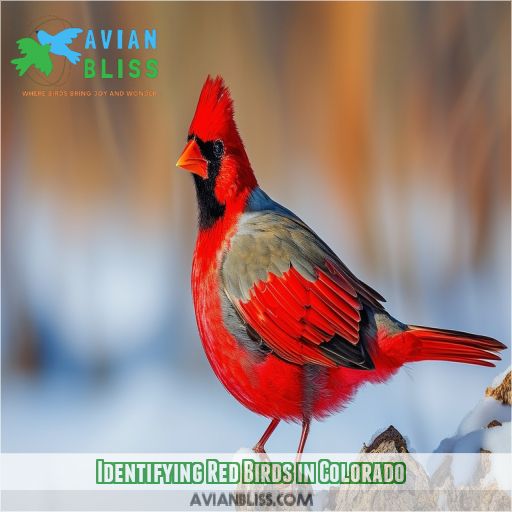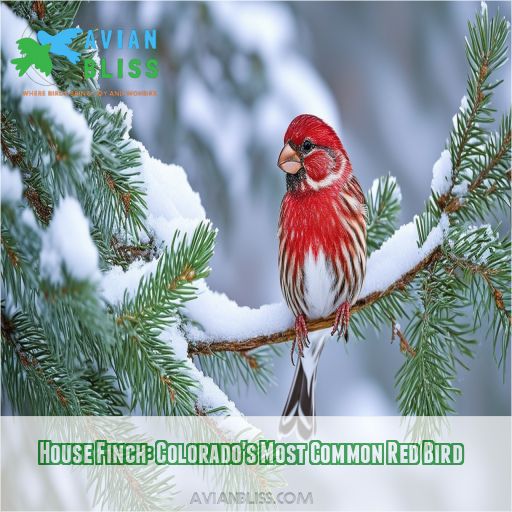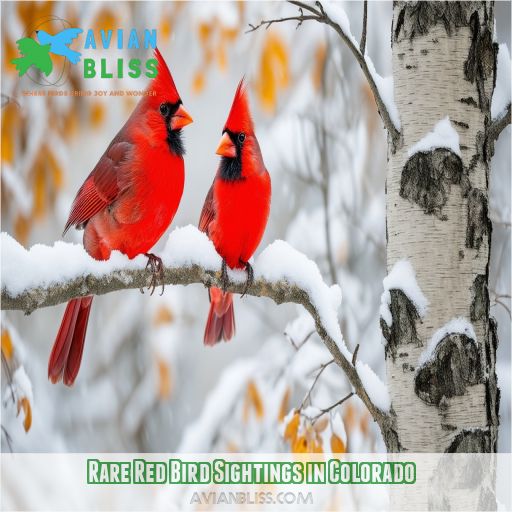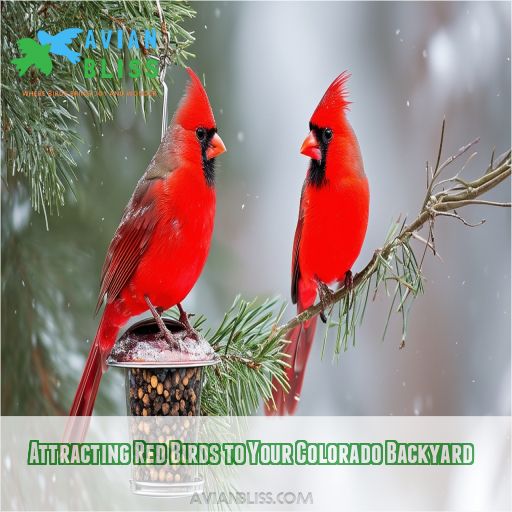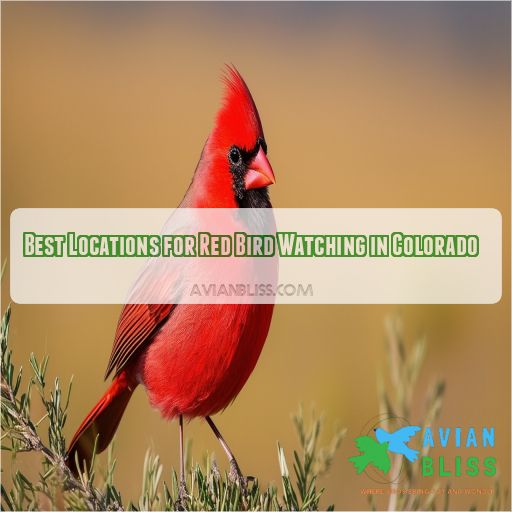This site is supported by our readers. We may earn a commission, at no cost to you, if you purchase through links.
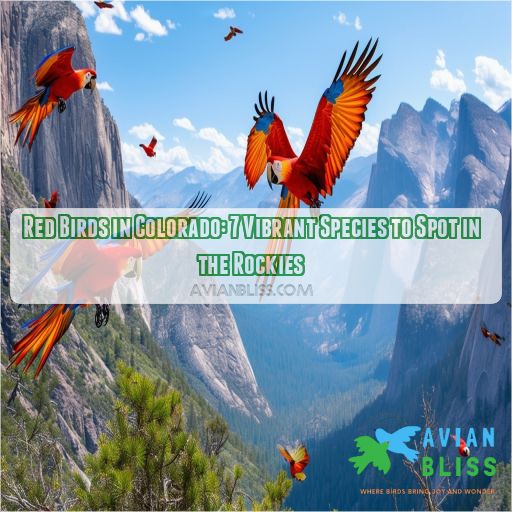
During winter, you might see the Pine Grosbeak with its reddish-pink feathers, often visiting coniferous forests. Look for the Red Crossbill in these same forests, recognizable by its unique crossed bill.
Occasionally, you may even spot a rare Northern Cardinal. Observing their varying habitats and behaviors can make your birdwatching experience more enriching, so explore further to uncover these vibrant species.
Table Of Contents
- Key Takeaways
- Red Birds Native to Colorado
- Identifying Red Birds in Colorado
- House Finch: Colorado’s Most Common Red Bird
- Pine Grosbeak: a Winter Visitor
- Red Crossbill: Coniferous Forest Specialist
- Rare Red Bird Sightings in Colorado
- Attracting Red Birds to Your Colorado Backyard
- Red Birds and Colorado’s Ecosystems
- Conservation Efforts for Colorado’s Red Birds
- Best Locations for Red Bird Watching in Colorado
- Frequently Asked Questions (FAQs)
- Does Colorado have red birds?
- What bird is red but not a cardinal?
- What is the most common red bird?
- What kind of bird is brown with a red chest in Colorado?
- What do red birds in Colorado eat?
- How do red birds survive Colorado winters?
- Are red birds aggressive in nature?
- Can red birds be pets in Colorado?
- What predators threaten red birds in Colorado?
- Conclusion
Key Takeaways
- Keep your eyes peeled for the rosy red House Finch, a common sight at bird feeders and a year-round resident of Colorado.
- During winter, don’t miss the chance to spot the Pine Grosbeak, a plump and charming visitor with a distinctive reddish-pink plumage.
- Look out for the Red Crossbill, a coniferous forest specialist with a unique crossed bill for extracting seeds from pine cones.
- If you’re lucky, you might catch a glimpse of a rare Northern Cardinal, a vibrant red bird that’s expanding its range into Colorado.
Red Birds Native to Colorado
Colorado is home to several native red bird species, including the House Finch, Pine Grosbeak, and Red Crossbill. Each of these birds has unique characteristics that make them well-adapted to the diverse habitats found throughout the state, from urban areas to high-altitude coniferous forests.
House Finch
You’ll often spot House Finches at your Colorado bird feeders. These red birds, smaller than American Robins, are year-round residents.
Males sport rosy hues, while females are streaked brown. Listen for their cheerful warbling songs during breeding season.
They’re skilled nest builders, crafting cozy homes in urban and suburban areas.
Unlike some species, House Finches don’t migrate, making them reliable backyard visitors throughout the year.
Pine Grosbeak
You’ll love spotting the Pine Grosbeak, a winter visitor to Colorado’s coniferous forests. These large, plump finches are a treat for birdwatchers with their distinctive appearance and behavior. Here’s what to look out for:
- Rosy-red males, grayish females with orange tints
- Thick, curved bills perfect for seed-cracking
- Gentle, fearless demeanor
- Tendency to travel in small flocks
- Preference for high-altitude habitats
Keep your eyes peeled for these charming birds at your winter feeders!
Red Crossbill
After spotting Pine Grosbeaks, you’ll want to keep an eye out for the Red Crossbill, another coniferous forest specialist.
These unique birds have adapted bills that cross at the tips, perfect for prying open pine cones.
You’ll find them foraging in Colorado’s mountain forests year-round, their nomadic nature tied to cone crop availability.
Listen for their distinctive jip-jip calls as they flit through the treetops.
Identifying Red Birds in Colorado
To identify red birds in Colorado, you’ll need to focus on their physical characteristics, habitat preferences, and behavioral traits. Look for distinguishing features like size, bill shape, and specific markings, while considering where you’re most likely to spot these vibrant species and observing their unique behaviors.
Physical Characteristics
When identifying red birds in Colorado, you’ll want to focus on distinctive features.
House finches sport rosy red heads and breasts, while pine grosbeaks are larger with reddish-pink plumage.
Red crossbills stand out with their unique crisscrossed beaks, perfect for extracting seeds from cones.
Don’t forget to look for subtler red accents on species like the northern flicker or hepatic tanager.
Binoculars can help you spot these vibrant feathered friends in the Rockies.
Habitat Preferences
When identifying red birds in Colorado, understanding their habitat preferences is essential. You’ll find these colorful creatures in diverse environments:
- Urban areas: House finches thrive near people, often visiting feeders
- Coniferous forests: Pine grosbeaks and red crossbills call these home
- Backyard sanctuaries: Create a haven for black-capped chickadees and downy woodpeckers
- Diverse landscapes: House sparrows adapt to many habitats
Conservation concerns such as habitat loss impact these species, making birdwatching ethics critical for their protection.
Behavioral Traits
When identifying red birds in Colorado, observing their behavioral traits is key. You’ll find unique characteristics that set each species apart. Here’s a quick guide to help you spot these vibrant birds:
| Species | Feeding Behavior | Social Habits | Nesting Preferences |
|---|---|---|---|
| House Finch | Frequent feeder visitor | Gregarious | Urban areas |
| Pine Grosbeak | Winter feeder specialist | Flocks in winter | Coniferous forests |
| Red Crossbill | Conifer seed expert | Nomadic flocks | Varies with cone crops |
| Northern Cardinal | Ground forager | Territorial pairs | Dense shrubs |
| American Goldfinch | Thistle seed lover | Small flocks | Late-season nesters |
House Finch: Colorado’s Most Common Red Bird
You’ll find House Finches throughout Colorado, easily recognizable by their rosy red heads and upper breasts in males. These small, sociable birds are frequent visitors to backyard feeders, where they feast on a variety of seeds including sunflower, safflower, and Nyjer.
Appearance and Identification
You’ll easily spot the House Finch, Colorado’s most common red bird. Males sport a rosy red head and breast, while both sexes have brown streaks on their backs and bellies. Their notched tails and conical beaks are distinctive features. Here are four ways to identify these charming birds:
- Listen for their cheerful warbling songs
- Watch for their quick, bouncy flight
- Notice their sociable behavior at feeders
- Observe their year-round presence, unlike migratory species
Habitat and Distribution
You’ll find House Finches throughout Colorado, from bustling cities to quiet suburbs. These adaptable red birds have made themselves at home in urban environments, nesting in building nooks and frequenting backyard feeders.
Their habitat preferences include parks, gardens, and open woodlands. While they’re year-round residents, some House Finches migrate short distances.
Their widespread distribution makes them a common sight for birdwatchers across the state.
Feeding Habits
You’ll often spot House Finches at your feeders, thanks to their diverse seed preferences. These adaptable birds love sunflower, safflower, and Nyjer seeds. In winter, they’ll flock to well-stocked feeders, their cheerful songs brightening cold days. By offering a variety of seeds, you’re not only attracting these colorful visitors but also helping them cope with habitat loss in urban areas.
Pine Grosbeak: a Winter Visitor
You’ll find Pine Grosbeaks visiting Colorado during the winter months, when they descend from higher elevations to forage in lower-lying areas. These large finches prefer coniferous forests but will venture into urban and suburban settings to take advantage of bird feeders stocked with sunflower seeds and fruits.
Seasonal Presence in Colorado
While House Finches are year-round residents, Pine Grosbeaks bring a splash of winter color to Colorado.
You’ll spot these robust red birds during their winter irruptions, when they migrate south from boreal forests. Their seasonal abundance varies, with some years bringing more visitors than others.
Keep an eye out for these charming winter guests at your feeders, especially in years when their northern food sources are scarce.
Preferred Habitats
You’ll find Pine Grosbeaks in Colorado’s coniferous forests, where habitat variation plays an important role in their winter presence. These red birds migrate to lower elevations during colder months, seeking shelter in spruce and fir stands.
Birdwatching ethics are essential when observing Pine Grosbeaks, as their preferred habitats face conservation challenges.
Feeding Behavior
You’ll often spot Pine Grosbeaks at feeders during winter, actively gobbling up sunflower seeds and fruits. These red birds have a gentle nature, allowing you to observe their feeding behavior up close. They’ll pluck berries from trees and shrubs, skillfully using their strong beaks to crack open seeds. Their presence adds a vibrant splash of color to Colorado’s winter landscape.
Red Crossbill: Coniferous Forest Specialist
Red Crossbills are unique among Colorado’s red birds due to their specialized bills, which are adapted for extracting seeds from conifer cones. You’ll find these nomadic finches in coniferous forests across the state, where they use their crossed mandibles to pry open pine cones and extract the nutritious seeds within.
Unique Bill Adaptation
While Pine Grosbeaks are winter visitors, Red Crossbills are year-round residents with a unique adaptation. You’ll be amazed by their distinctive bill structure, perfectly suited for their coniferous habitat. The crossbill’s beak morphology is a marvel of evolution, offering several benefits:
- Specialized crossed tips
- Enhanced seed extraction
- Improved feeding efficiency
- Reduced competition with other species
This adaptation allows them to thrive in Colorado’s pine forests, making them true habitat specialists.
Diet and Foraging Techniques
With their specialized bills, Red Crossbills are masters at extracting seeds from conifer cones. You’ll find them foraging in Colorado’s pine forests, their red plumage a striking contrast against green needles.
They’re not picky eaters, adapting their diet to available cone crops. This flexibility influences their migration patterns, as they follow food sources rather than seasonal changes.
Their unique feeding strategy plays a key role in conservation efforts.
Breeding Habits in Colorado
You’ll find Red Crossbills nesting in Colorado’s coniferous forests year-round. Their breeding habits are closely tied to cone crop cycles. During courtship, males feed females in a charming display. Females build cup-shaped nests high in trees, laying 3-4 pale blue-green eggs with dark markings. Chicks hatch after about two weeks, and both parents work tirelessly to feed their growing brood.
Rare Red Bird Sightings in Colorado
While House Finches, Pine Grosbeaks, and Red Crossbills are common red birds in Colorado, you might be lucky enough to spot some rare visitors. The Northern Cardinal, Scarlet Tanager, and Summer Tanager occasionally make appearances in the state, offering exciting opportunities for birdwatchers.
Northern Cardinal
While you’re on the lookout for Red Crossbills, keep your eyes peeled for another red stunner: the Northern Cardinal. Though rare in Colorado, these vibrant birds are expanding their range. Here’s what you need to know:
- Range expansion: Cardinals are slowly moving westward into Colorado.
- Habitat preferences: Look for them in dense shrubs and urban areas.
- Breeding success: Sightings are increasing, suggesting potential nesting populations.
You’ll feel a rush of excitement if you spot this iconic redbird in the Rockies!
Scarlet Tanager
You might be lucky enough to spot a Scarlet Tanager in Colorado during its migration. These vibrant birds, with their striking red plumage and black wings, pass through the state on their way to breeding grounds.
Keep an eye out for them in deciduous forests. While rare, their conservation status remains stable.
Summer Tanager
You might spot the Summer Tanager in Colorado, but it’s a rare treat. These vibrant red birds occasionally venture into the state’s southeastern corner.
Listen for their distinctive "piki-tuki-tuk" call. While they don’t typically nest here, keen birders have reported sightings.
To identify them in the field, look for their all-red plumage and pale, thick bill.
Their conservation status remains stable, but habitat loss is a concern.
Attracting Red Birds to Your Colorado Backyard
To attract red birds to your Colorado backyard, you’ll need to provide the right food sources and create a welcoming environment. Start by setting up appropriate feeders with preferred seeds, and consider landscaping your yard to include native plants that offer natural food and shelter.
Feeder Types and Placement
To attract red birds to your Colorado backyard, consider their feeder preferences and placement strategies. Platform feeders work well for many species, while tube feeders suit House Finches. Place feeders near natural cover like trees or shrubs, providing safety and perches.
Consider multiple feeding stations to reduce competition. Remember, creating bird-friendly yards isn’t just about feeders; incorporate native plants and water sources too.
Winter feeding can be especially beneficial for these colorful visitors.
Preferred Seeds and Foods
To attract red birds to your Colorado backyard, stock your feeders with their favorite seeds.
Sunflower seeds are a top choice, especially for House Finches and Pine Grosbeaks. Nyjer seeds appeal to finches, while safflower seeds are great for year-round feeding.
Consider offering specialized bird seed blends during winter months to support Red Crossbills and other species.
Keep feeding stations well-stocked to guarantee a consistent food source for your colorful visitors.
Creating a Bird-Friendly Environment
To create a bird-friendly environment, go beyond feeders. Plant native shrubs and trees that offer shelter and food sources.
Install a birdbath for fresh water, especially during dry spells. Minimize pesticide use to protect insects, a vital food source for many birds.
Consider adding nesting boxes for cavity-nesters.
Red Birds and Colorado’s Ecosystems
Colorado’s red birds play vital roles in their ecosystems through seed dispersal and insect control. As they feed on native plants and insects, these vibrant species contribute to the balance and biodiversity of the state’s varied habitats.
Role in Seed Dispersal
Red birds play a pivotal role in seed dispersal throughout Colorado’s ecosystems. As they migrate and forage, these vibrant species unknowingly transport seeds over varying distances.
Their unique seed storage techniques and digestive systems allow for efficient dispersal, promoting genetic diversity among plant populations. This bird-tree interaction is essential for forest regeneration and ecosystem health.
Understanding these processes aids in red bird conservation efforts and maintaining Colorado’s diverse landscapes.
Interactions With Native Plants
You’ll find that Colorado’s red birds have a symbiotic relationship with native plants. They rely on these plants for food and shelter, while also playing a vital role in pollination and seed dispersal. Red bird diets often include:
- Bright red berries of chokecherry bushes
- Pine seeds from towering evergreens
- Nectar from vibrant columbine flowers
- Buds and catkins from aspen trees
These interactions shape the landscape, influencing Red bird breeding patterns and migration routes. Their melodious songs often accompany these plant-based activities, creating a harmonious ecosystem.
Impact on Insect Populations
While red birds play a critical role in seed dispersal, they’re also key players in controlling insect populations.
Red birds in Colorado, especially during breeding season, rely heavily on insects for protein. They’ll snatch up caterpillars, beetles, and flies, helping to keep these populations in check.
This natural pest control benefits both ecosystems and your backyard garden.
Conservation Efforts for Colorado’s Red Birds
Conservation efforts for Colorado’s red birds focus on protecting their habitats and monitoring population trends. You can contribute to these efforts by participating in citizen science initiatives, which help researchers gather valuable data on red bird species across the state.
Habitat Protection
To protect red birds in Colorado, focus on these measures:
- Conservation measures: Preserve and restore habitats by planting native vegetation to support nesting and food resources.
- Birdwatching ethics: Stay a safe distance to minimize disturbance and avoid nesting areas.
- Invasive species threats: Control non-native plants and animals that alter native habitats, impacting red bird populations.
Monitoring Population Trends
Monitoring population trends of Colorado’s red birds involves citizen science, habitat analysis, and conservation strategies. Utilizing long-term data, these efforts help track species distributions and identify key habitats. Robust monitoring allows for targeted conservation efforts, ensuring these vibrant birds thrive while providing critical insights into ecosystem health and changes .
Citizen Science Initiatives
You can aid in red bird conservation through citizen science projects. These initiatives allow you to report sightings and behaviors, contributing substantially to red bird distribution data. Platforms like eBird and Project FeederWatch gather citizen science data, proving invaluable for monitoring trends and habitat use, thereby ensuring effective conservation strategies for Colorado’s vibrant red birds.
Best Locations for Red Bird Watching in Colorado
Start your exploration of Colorado’s vibrant red birds by visiting diverse habitats like urban and suburban areas, mountain regions, and state parks and wildlife areas. Each location offers unique opportunities to observe species like the House Finch, Pine Grosbeak, and Red Crossbill, enhancing your birdwatching experience .
Urban and Suburban Areas
In urban and suburban areas of Colorado, you’ll find the popular House Finch. Their rosy hue brightens backyards, especially near feeders. Red Crossbills, with their unique bills, occasionally visit these regions too. Northern Cardinals, rare in Colorado, may surprise you, while the Pine Grosbeak appears during winter. Keep an eye out for Scarlet Tanager sightings .
Mountain Regions
Exploring Colorado’s mountain regions offers exceptional opportunities to spot red birds. Focus on areas with coniferous forests, where Pine Grosbeaks and Red Crossbills thrive due to their specific adaptations, like breaking into tightly closed cones. Their distribution and migration patterns make winter months particularly rewarding for birdwatching enthusiasts. Conservation efforts help maintain red bird diversity and protect their habitats.
State Parks and Wildlife Areas
Explore red bird conservation in State Parks and Wildlife Areas across Colorado. Focus on habitat restoration at places like Red Lion State Wildlife Area , and practice birding ethics. Observe diverse species and learn from ongoing avian research at Black Mesa State Park and Mesa Verde National Park . Remember, each location offers unique opportunities for species diversity and insights.
Frequently Asked Questions (FAQs)
Does Colorado have red birds?
You’ll be delighted to find red birds in Colorado, including House Finches and Pine Grosbeaks. These vibrant species, along with the occasional Northern Cardinal, add a splash of color to your bird-watching adventures .
What bird is red but not a cardinal?
The House Finch is a red bird often confused with cardinals. Male House Finches have a rosy red head and upper breast, brown streaks on their back and belly, and a notched tail .
What is the most common red bird?
Crimson cardinal commonly captivates with brilliant red plumage and bold black mask across much of North America, particularly prevalent in the east and south. Their rich songs enliven environments, making them a beloved backyard bird .
What kind of bird is brown with a red chest in Colorado?
You’re likely spotting a House Finch in Colorado. Males have a rosy red head and upper breast, with brown streaks on their body, while females are brown with streaks .
What do red birds in Colorado eat?
Get ready for an avian feast! In Colorado, red birds like the House Finch and Pine Grosbeak devour seeds, while birds like the Red Crossbill love breaking into tightly closed cones to satiate their hunger .
How do red birds survive Colorado winters?
Red birds in Colorado, like House Finches and Red Crossbills, survive winters by seeking shelter, fluffing feathers for insulation, and consuming high-energy foods such as seeds from feeders and tightly closed pine cones .
Are red birds aggressive in nature?
Northern Cardinals, known to attack their reflections, can be particularly aggressive, especially during breeding season when defending territories . Males are more territorial and often engage in extended confrontations with intruders .
Can red birds be pets in Colorado?
In Colorado, certain red birds can’t be kept as pets due to state wildlife regulations and protections. Species such as House Finches and American Robins fall under these rules, prohibiting their captivity .
What predators threaten red birds in Colorado?
Notably, House Finches, which are frequently sighted in Colorado, face threats from native predators like Northern Goshawks, American Crows, and Western Tanagers, which can prey on them, especially during nesting seasons .
Conclusion
Why not make your next birdwatching adventure in Colorado a quest to find red birds?
With species like the House Finch, Pine Grosbeak, and Northern Cardinal, your chances to spot vibrant red birds in Colorado are plenty.
You’ve learned about their habitats, behaviors, and ways to attract them to your yard.


